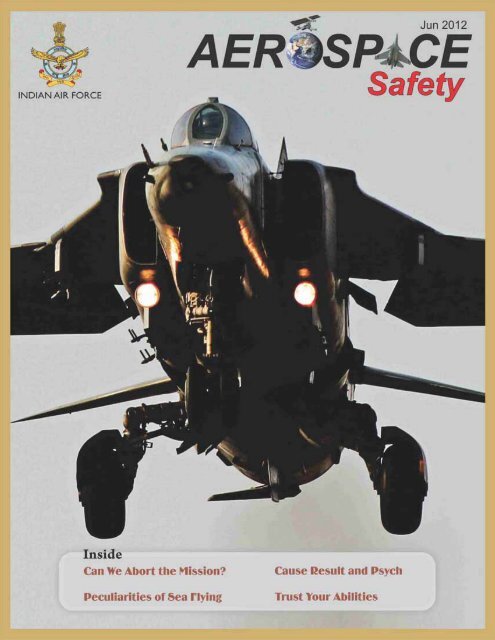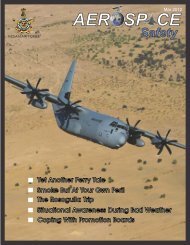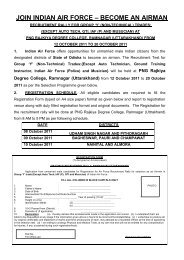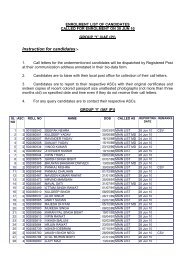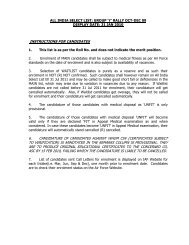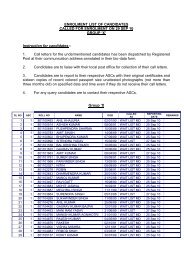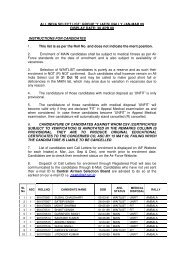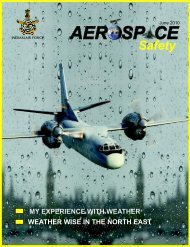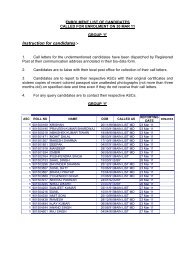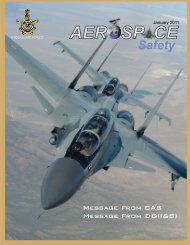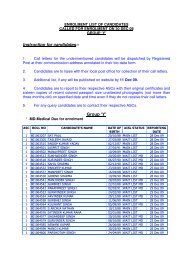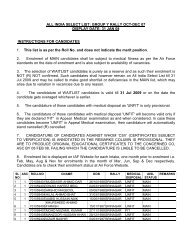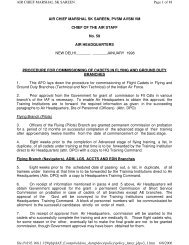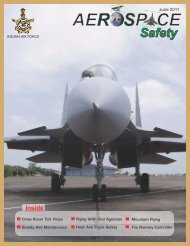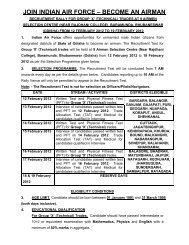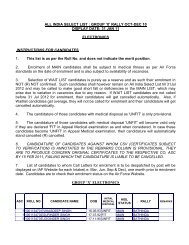You also want an ePaper? Increase the reach of your titles
YUMPU automatically turns print PDFs into web optimized ePapers that Google loves.
Gp Capt (Retd) Rajesh Kumar<br />
2 Aerospace Safety J u n e 2 0 1 2<br />
INDIAN AIR FORCE
Imagine an unsuspecting bunch of Armoured<br />
Corps personnel, engrossed in live firing at a<br />
range in the North West sector. Tanks and APCs<br />
milling around, kicking up a lot of dust and the RSO<br />
trying his best to peer through the obscurities, to<br />
keep track of results of firing. It was quite akin to<br />
a real battle scenario and the prevailing visibility<br />
over the range did not make matters any easier<br />
for any one. They had a task at hand and were<br />
doing their best to get the maximum out of the<br />
exercise underway. Little did they know that an<br />
unpleasant surprise was already beginning to<br />
unfold and that their exercise was about to turn a<br />
lot more realistic.<br />
orbiting endlessly in an attempt to pick up the<br />
targets. The local SU had tried its best to guide<br />
the hapless pilot but to no avail. Finally, good<br />
sense prevailed and he decided to call off the<br />
mission. The RSO too heaved a sigh of relief and<br />
was happy to hear the pilot change over to the<br />
SU channel for the trip back to base.<br />
Since the range had not been sighted, the<br />
return navigation too started off on an uncertain<br />
footing. Probably the pilot put all his trust in his<br />
on-board systems and hoped that eventually the<br />
SU would pick him up and help him get back<br />
home. Nothing wrong with that, but it certainly<br />
Some distance to the West, a lone MiG-27<br />
was involved in heavy armament work over the<br />
Air Force portion of the firing range, with 2 x 500<br />
Kg bombs. Though a simple enough exercise,<br />
things did not seem to be going well that day.<br />
The problem was understandable and had been<br />
experienced by many pilots in the past. The<br />
problem was that the pilot was not able to make<br />
contact with the range or any familiar feature in<br />
its close vicinity. In such sorties, fuel is always at<br />
a premium so one does not enjoy the luxury of<br />
would have been wiser to confess that one was<br />
heading back and was somewhat unsure of his<br />
ground position. Time ticked away. The RSO in<br />
the meantime prepared to close the range and<br />
call it a day which had been quite uneventful till<br />
the small aberration, a little while ago. All of a<br />
sudden the aircraft that had just left range, piped<br />
up on R/T announcing that he now had the<br />
target in contact and was seeking permission<br />
to go in for ‘direct live’. Fuel considerations<br />
seemed to have weighed on the RSO’s mind as<br />
INDIAN AIR FORCE 2 0 1 2 J u n e Aerospace Safety 3
well and he decided to clear the pilot for direct<br />
live, without the mandatory Safety Height Run<br />
first. Also, he did not establish visual contact with<br />
the aircraft anywhere on the circuit. This should<br />
have woken him up but events that had been set<br />
in motion probably were too fast for him to evoke<br />
a rational action. Even when the pilot called out<br />
that he was now rolling in live, the RSO did not<br />
react. A confident call, “You are clear live”, was<br />
ground. I, as the Flight Commander of the unit<br />
got an unwelcome call from the COO and he<br />
wanted to know whether any of our aircraft<br />
was still operating over the range. His very tone<br />
suggested that something was drastically wrong<br />
and soon the AOC and the COO descended<br />
on the dett. To everyone’s horror, it was quite<br />
obvious that a fighter had just dropped two<br />
live bombs bang in the middle of the army<br />
all that he transmitted. The next call from the<br />
pilot announced, “Bombs Gone, Switches Safe,<br />
returning to base”. But even after a minute, the<br />
RSO had not spotted any bomb impact on the Live<br />
Bombing Target (LBT) or anywhere in the range<br />
area. The natural thing then was to put down the<br />
binoculars and call up the pilot to cross check<br />
if bombs had indeed been released. On being<br />
confirmed in the positive, the RSO responded<br />
by transmitting, “Bombs not sighted, probably<br />
gross undershoot. You are clear to change<br />
over to the SU”. The range was closed thereafter<br />
and the pilot navigated safely back to his base,<br />
basking in the belief that the mission had finally<br />
been accomplished. The mission in fact had gone<br />
wrong completely.<br />
Things seemed to have settled down to<br />
routine for the pilot but all was not well on the<br />
ranges and naturally, the guys in the OG were<br />
furious. Fortunately, no one was hurt and there<br />
was no damage to any vehicle or structure. The<br />
next dignitary to arrive in the unit was the Air I<br />
from the Command Headquarters and I was<br />
told to get busy writing an Executive Report on<br />
the pilot. His fighter flying days were over,<br />
all because of one avoidable mistake that he<br />
failed to correct on time.<br />
It would be worth pondering over the<br />
following :<br />
The location of this particular range<br />
is such that many times picking up targets is<br />
difficult. The navigation to the range therefore<br />
has to be taken very seriously. In fact, the<br />
navigation to any destination has to be taken<br />
very seriously. Odd instances of inaccuracies<br />
4 Aerospace Safety J u n e 2 0 1 2<br />
INDIAN AIR FORCE
creeping in are understandable... but think...was<br />
there an excuse for the pilot not being able to<br />
find the range in broad daylight<br />
Fuel considerations notwithstanding,<br />
permission to go in for direct live for aircraft<br />
operating alone, must be granted only under<br />
exceptional and pre-briefed circumstances. What<br />
such exceptional circumstance are, need to be<br />
spelt out unambiguously and briefed properly.<br />
Since the LBT at this range or for that<br />
matter at any other heavy armament range would<br />
generally be obscured because of weapons used<br />
earlier, be aware of the other features on and<br />
around the range to help you identify the targets<br />
correctly.<br />
Once the decision to abort the mission<br />
had been taken, suddenly reverting and seeking<br />
permission for direct live was certainly not in<br />
order. The pilot was probably not comfortable<br />
with the idea of landing with two bombs under<br />
slung. Operating manuals do permit landing<br />
under such configuration, but don’t you think all<br />
operators should be aware of this<br />
Should the RSO have cleared the pilot<br />
for a direct live attack without the Safety Height<br />
Run Again a matter of practice but the pitfalls of<br />
doing so must be understood.<br />
Now for a dive bomb attack, there is no<br />
way that an aircraft in dive will not be visible to<br />
the RSO. Surely, if the visibility is that bad, won’t<br />
the better option be to close the range<br />
Having cornered the RSO into clearing<br />
him for a direct live attack, how about the pilot<br />
confirming with other features around, what he<br />
believed to be the LBT and that he indeed was<br />
going in for the correct target.<br />
During the entire episode, the RSO did not<br />
spot the aircraft. Worse still, he did not even hear<br />
it. Should this have forced him to do something<br />
other than what he eventually did<br />
The RSO did not intervene even when the<br />
aircraft confirmed rolling in live and he was yet<br />
to establish visual contact. He simply assumed<br />
that the pilot eventually had things under control<br />
and was going in for the correct target. The pilot<br />
too assumed the same and pressed on with<br />
the attack. Remember the old adage, ‘DO NOT<br />
ASSUME. It makes an ASS out of U and ME’. In<br />
this case, it certainly did and consequences could<br />
have been worse.<br />
Getting ‘Bombs Away’ is the sole desired<br />
culmination in such a live firing mission but<br />
please be sure, the bombs are aimed at the<br />
desired target and nowhere else. Live bombs<br />
are dangerous instruments with considerable<br />
destructive power. Therefore there can be no<br />
complacency in the manner they are released.<br />
When in doubt ... DO NOT PRESS THE TRIGGER.<br />
A large number of seemingly weird<br />
incidents happen at firing ranges everywhere.<br />
Some result in very unpleasant consequences for<br />
players involved and many times even for those<br />
who are caught unaware on the ground, for no<br />
fault of theirs. Sharing your experiences with the<br />
environment can certainly increase awareness<br />
and minimise chances of recurrence of such<br />
avoidable incidents. If you are in agreement with<br />
this, then please do get in touch with the ‘editor’<br />
with your story without any delay as it is quite<br />
likely that someone else could enact something<br />
close to what you did and you could help him<br />
avert the same !<br />
- Gp Capt (Retd) Rajesh Kumar<br />
Editor’s Comments :<br />
Inability to spot the range is a situation that<br />
many aircrew would have experienced.<br />
However, the lesson for all is to avoid the<br />
compulsion to believe that everything is<br />
fine, when it actually isn’t. Every<br />
tale may not have a happy<br />
ending!<br />
INDIAN AIR FORCE 2 0 1 2 J u n e Aerospace Safety 5
Wg Cdr Juhi Borgohain<br />
6 Aerospace Safety J u n e 2 0 1 2<br />
INDIAN AIR FORCE
Mental health is an important aspect of<br />
total positive health. Every physical<br />
ailment has a mental component and<br />
every mental illness has a physical component.<br />
The WHO Expert Committee defines mental<br />
health as ‘the capacity of an individual to<br />
establish harmonious relations with others and<br />
to participate in or contribute constructively to<br />
change in the social environment’.<br />
Stress<br />
There is a lot of talk going around these days<br />
about stress. Almost every week, some medical<br />
journal or lay magazine brings out an article<br />
on this issue. Most of the<br />
time, doctors also tell their<br />
patients to cut down on<br />
their stress. However, to<br />
the general public and<br />
patients, it is quite vague and<br />
confusing. What is stress Why does it occur Can<br />
we do away with it Such questions can be quite<br />
intriguing.<br />
Stress Response<br />
It is actually not the stress that concerns us;<br />
what really concerns us is the “Stress Response”.<br />
This is the sum total of body reaction, both<br />
physiological and psychological, in response to a<br />
“stressor”. So, it is not really the “Stressor” (i.e. the<br />
situation) that leads to stress but our perception<br />
of that event, the meaning we attach to it and<br />
the way we react or respond to it, that leads to<br />
symptoms or diseases of stress.<br />
Stimuli from the environment or thoughts<br />
generated within the mind become amicable or<br />
inimical depending on whether they generate<br />
positive or negative effect. An inimical reaction<br />
brings on the fight response if one is angry and<br />
the flight response if one is insecure. We can alter<br />
our stress response from inimical to amicable<br />
and thereby cope with the stress stimulus.<br />
For example, let us say, to jump down to the<br />
ground from the roof, just 12 feet high, may be<br />
tremendously stressful for most of us. Majority<br />
of us, on looking down at the ground, would<br />
feel “butterflies in the stomach”. However, for a<br />
seasoned paratrooper, it would be fun. So, it is<br />
not the stressor (events, persons or environment)<br />
but our own interpretation and how we react<br />
decides whether we will get “stressed” or not.<br />
The Life Saving Stress Response<br />
The stress response in our<br />
body is meant for a protective<br />
and desirable reason. It is rather<br />
life saving. Evolution wise, our<br />
primitive ancestors, the Early Men,<br />
were exposed to various dangers at<br />
most unsuspected times - eg -when<br />
a hungry tiger suddenly pounced on<br />
them. To survive such flash emergencies,<br />
nature developed the “stress response” or “fight or<br />
flight” response in our body. Within milliseconds<br />
this would cause the heart to beat faster and<br />
more strongly and the blood pressure to rise (so<br />
that more and more blood laden with oxygen and<br />
glucose could go to the muscles, to either fight it<br />
out or run away). The breathing would become<br />
deep and extra glucose would be pumped into<br />
the blood by the liver, so that more of sugar and<br />
oxygen could be taken by the blood to the active<br />
muscles. Kidneys start saving water so that blood<br />
volume can increase, digestion reduces and<br />
blood from digestive organs is diverted to the<br />
active muscles. In addition, the blood clotting<br />
mechanism would increase so as to quickly seal<br />
off the wounds and minimize blood loss due to<br />
bleeding from injuries.<br />
So, where does all this fit into the problems<br />
of stress that we are talking about Well, the<br />
same stress response which was so protective<br />
during the evolutionary stages of human race<br />
has become a major hazard to our health. In<br />
our modern age life, we seldom face the kind of<br />
physical danger for which nature had designed<br />
the stress response. Even today, we need it on<br />
INDIAN AIR FORCE 2 0 1 2 J u n e Aerospace Safety 7
World Health<br />
Organisation<br />
The WHO expert committee defines<br />
Mental Health as ‘the capacity of an individual<br />
to form harmonious relations with others and<br />
to participate in or contribute constructively<br />
to change in the social environment’.<br />
some relatively uncommon occasions, as when<br />
suddenly threatened by a robber on a lonely<br />
track.<br />
The Harmful Stress Response<br />
We cannot have our body and mind in a state<br />
of alarm for prolonged periods of hours (may<br />
be, weeks or months continuously), to negotiate<br />
modern day “stressors” or challenges like having<br />
a difficult boss, staying separate from the<br />
family, preparing for an important competition,<br />
difficulties in career, or lesser difficulties like<br />
having a flat tyre while driving on the highway.<br />
Even for these small hassles, the body’s stress<br />
response remains massive or perpetual. The<br />
increase in blood pressure and heart rate,<br />
increase in blood sugar, increase in blood clotting<br />
mechanisms, muscles becoming taut, lowering of<br />
the immune defence of the body and reduction<br />
in the digestive process continue for long periods<br />
and lead to major diseases like hypertension,<br />
diabetes, peptic ulcer, infections, muscular and<br />
joint pains. It is therefore essential for us to learn<br />
ways and means to calm down our reactions to<br />
the stressor, and to develop adequate “coping<br />
mechanisms” to tackle the stressors of day-to-day<br />
living.<br />
The Adverse Effects of Stress<br />
Stress affects our health in a wide variety<br />
of ways. Psycho-somatic effects include IHD,<br />
hypertension, diabetes mellitus, peptic ulcers,<br />
predisposition to certain cancers, lowered<br />
immune functioning, arthralgias and myalgias,<br />
tension - headaches, etc. Emotional effects<br />
include suppressed hostility, anger, panic,<br />
irritability, “burnout”, fatigue, sleep disorders,<br />
anxiety and depression.<br />
Roadmap for Preventing and Managing<br />
Stress<br />
Learning and practising the power<br />
of “Now”. To have an intense awareness of<br />
the present moment, rather than brooding<br />
over the past which we cannot change, or<br />
contemplating about the future that we have<br />
no control over.<br />
Develop Personal Financial<br />
Management Skills<br />
Develop Time-Management Skills. Time<br />
is a premium entity. Managing available time<br />
in the most gainful and productive manner is<br />
a skill. Improper time management leads to<br />
procrastination and stress.<br />
Maintain Good Health. Even minor<br />
ailments such as common cold makes one<br />
feel demoralized; major diseases like diabetes<br />
would then certainly produce tremendous<br />
stress. One should therefore make conscious<br />
efforts to maintain good health and prevent<br />
such diseases.<br />
Undertake Regular and Brisk Physical<br />
Exercise and Yoga. Exercise leads to release<br />
of beta-endorphins which act on the brain and<br />
bring about a feeling of euphoria, well-being,<br />
confidence, alertness and decrease in pain<br />
sensations. This “high” state acts as an antidote<br />
to stress.<br />
8 Aerospace Safety J u n e 2 0 1 2<br />
INDIAN AIR FORCE
Train the Family Members for Difficult<br />
Situations and Spend “Quality Time” with Your<br />
Family. One of the major precursors of stress is<br />
the feeling of being “isolated” or “disconnected”.<br />
When you spend quality time with your family<br />
members, you feel connected, without any feeling<br />
of isolation, which helps preventing stress.<br />
a particular task or favour being asked of you is<br />
unjustified or beyond your capabilities.<br />
Avoid Ego Struggles. We sometimes act as<br />
if it is more important to be seen as “right” rather<br />
than be happy. It is best to avoid the tendency to<br />
forcefully convince others when it is not so critical<br />
Practise Assertiveness skills. Assertiveness<br />
is the honest expression of what you feel and<br />
want from others, without trying to force them<br />
to give it. It is particularly useful when dealing<br />
with “difficult” people and the consequent stress.<br />
Some of the characteristics of assertive behavior<br />
which need to be developed are :<br />
‣ Speak up for yourself, for your needs and<br />
rights, while letting others speak for themselves.<br />
‣ Develop a sense of respect for yourself as well<br />
as for others.<br />
‣ Protest, maybe politely but definitely, against<br />
unfair treatment or unjustified criticism.<br />
‣ Take honest responsibility for your own<br />
wrongs / mistakes, but at the same time, do not<br />
take responsibility for someone else’s lapses.<br />
‣ Say “NO”, maybe politely, when you feel that<br />
to your own health and well-being. Doing so<br />
will help you escape a great deal of unnecessary<br />
stress.<br />
Develop Social Support Systems. It is<br />
a very wise investment to put in some effort to<br />
develop some close friends towards whom we<br />
can look up for support during stressful situations.<br />
Others<br />
Adopt traditional cultures<br />
Practise “Relaxation” techniques<br />
Progressive, deep muscular relaxation<br />
Practise methods to get a good sleep<br />
Spiritual Practices, Praying and Meditation<br />
and<br />
Promote humor and laughter<br />
-Wg Cdr Juhi Borgohain<br />
INDIAN AIR FORCE 2 0 1 2 J u n e Aerospace Safety 9
Sqn Ldr R Kadyan<br />
Since the dawn of aviation industry we have<br />
had many accidents owing to marginal<br />
weather conditions. ‘Respect weather and<br />
decide in time’ is the golden rule and if adhered<br />
to will definitely help in preventing accidents/<br />
incidents.<br />
It was one of the monsoon months of 2009.<br />
I was posted to a premier fighter base in the<br />
Northern region. On this fateful day, I was part<br />
of a 4 ac formation tasked to carry out a dummy<br />
strike over another airfield in the J&K sector. The<br />
latter part of our route involved considerable<br />
amount of valley flying. I had recently attained<br />
my supervisory status and was quite eager to fly<br />
this mission. Due to bad weather at the target<br />
base our early morning scheduled take off got<br />
considerably delayed. Eventually by afternoon,<br />
on getting latest weather, we got airborne.<br />
The enroute weather was as predicted and<br />
did not hamper the safe transit till we hit the<br />
foothills. As we crossed over the first ridge line,<br />
the difficulty quotient of the exercise increased as<br />
it entailed RV with two ‘Tied Escorts’ in marginal<br />
weather conditions. A successful RV with escorts<br />
was achieved and the mission continued as<br />
briefed. Looking towards the hills along the<br />
planned route, I spotted a thick black layer of<br />
towering clouds. Out of sheer restlessness, I piped<br />
up on R/T for a weather update from an enroute<br />
fighter base. The feedback which we received was<br />
base specific and no update on weather over the<br />
hills was given. The Escort Leader also updated<br />
reasonable vertical development of this clouding.<br />
With every passing second the formation got<br />
closer and my restlessness kept increasing. Our<br />
six ac formation was a minute away from the<br />
planned intercept leg when broken clouding<br />
started interfering with our formation keeping.<br />
The formation leader ordered a few side steps to<br />
avoid patches of clouds. I was sure the formation<br />
members must have felt uncomfortable flying in<br />
that scenario.<br />
Soon, the escorts were out of sight as they<br />
resorted to height separation due to clouding. The<br />
formation keeping was getting challenging and<br />
the situation was expected to get worse once the<br />
tactical action would commence which included<br />
loss of contact, height separation, escape routes<br />
etc. With the increase of clouding my discomfort<br />
10 Aerospace Safety J u n e 2 0 1 2<br />
INDIAN AIR FORCE
level was rapidly increasing. Eventually, I piped up<br />
on R/T and asked the leader to abort the mission.<br />
I expected a positive reply and mentally prepared<br />
myself for subsequent actions. However, when<br />
the leader called to ‘continue’, I was shocked.<br />
My professional competence was getting<br />
sandwiched between taking a safe decision and<br />
continuing with the mission. Our formation also<br />
had pilots with lesser experience who were also<br />
continuing without expressing their discomfort.<br />
The reason for their silence was not difficult to<br />
predict at that moment. They behaved as true<br />
followers with immense faith in their leader. This<br />
fact hit my professional ego - ’if they could do it<br />
then why not me’. The ‘Formation’ integrity was<br />
being challenged at every step due to extended<br />
trails of clouding and the worst was yet to come.<br />
Finally, one of the junior pilots expressed his<br />
discomfort on R/T and requested to abort the<br />
mission. By this time our ‘Formation’ had already<br />
entered the black turbulent wall of clouds. A<br />
turn about was ordered after establishing height<br />
separation which was a bit relaxing but a big<br />
challenge of avoiding a mid air collision loomed<br />
large! Our ‘Formation’ at this time was over the<br />
hills where the ‘Route Safety Altitude’ was as<br />
high as 16500’. The ordered maneuver was being<br />
executed with standard height separation.<br />
A conventional turn-about in a large formation<br />
in perfect VMC requires clearances from various<br />
members to avoid collision whereas in the said<br />
condition it was getting executed in nil visibility<br />
conditions, without any clue of relative positions<br />
of the other members! The turbulence was so<br />
severe that 1000’ height separation appeared<br />
very less. All of us were flying on instruments<br />
and struggling against turbulence to maintain<br />
flying parameters. The thought of other aircraft in<br />
close proximity was the scariest of all. The stage<br />
was all set for disorientation i.e large formation,<br />
height maintenance, turbulent weather and nil<br />
visual references. The silence was broken by two<br />
R/T calls- first one of ‘HUD failure’ from No.2 and<br />
the second of ‘TGT Amplifier failure’ from the<br />
formation leader.<br />
After a long battle (short on time domain)<br />
with our machines and weather, the formation<br />
eventually broke clouds. The sky was visible in<br />
patches. It took another couple of minutes and a<br />
long series of R/T calls and aircraft manoeuvring<br />
before we could re-establish our formation and<br />
recover at our base. During the mission debrief<br />
few more tales about individual discomfort<br />
came to light and the scariest amongst all<br />
was the one associated with ‘HUD failure’. ‘All<br />
is well that ends well’ applied perfectly to our<br />
formation<br />
A few lessons emerged out of this incident<br />
which should make us wiser :-<br />
‘Respect Weather’- universally published<br />
but least followed.<br />
A perfect balance should be maintained<br />
between professional ego/competence and<br />
safety.<br />
Every member of a formation is equally<br />
responsible for formation safety. Decide and act<br />
in time before things go out of hand.<br />
Formation leaders must take decisions<br />
based on the least experienced member.<br />
Respect decisions of juniors as well.<br />
Do not let your ego overpower a safe<br />
decision.<br />
During peace time missions do not push<br />
your luck too hard for it to favour you on every<br />
occasion.<br />
Peculiarity of weather over hills should<br />
be emphasized in detail for missions involving<br />
valley/hill transit.<br />
Let your experience benefit others for a<br />
better flight safety environment.<br />
-Sqn Ldr R Kadyan<br />
INDIAN AIR FORCE 2 0 1 2 J u n e Aerospace Safety 11
Sqn Ldr Binu Venugopal<br />
12 Aerospace Safety J u n e 2 0 1 2<br />
INDIAN AIR FORCE
Safe guarding the EEZ and sea lanes is<br />
required, keeping in view that India is an<br />
emerging market, with a rapid growth in sea<br />
trade. Thus, to ensure unhindered growth rate,<br />
the EEZ and sea lanes need to be kept safe and<br />
secure all the time. To achieve the said objective,<br />
the <strong>Indian</strong> Armed forces have embarked on the<br />
modernization of Air and Naval forces. The <strong>Indian</strong><br />
Air Force has increased the quantum of maritime<br />
operations in its island regions, scheduled<br />
couriers operations and various detachments.<br />
The surface of the earth is covered by 71%<br />
water and 29% land. Flights over the oceans<br />
have few or no diversions. Consequently,<br />
communications and navigation, which are<br />
essential for conduct of any flight, are also limited<br />
due to the vast distances between successive<br />
stations. The following are some hazards that are<br />
associated with flying over the sea: -<br />
Long Eventless Flights. Long flights as said<br />
earlier, are a feature of sea flying. Though they<br />
appear innocuous to pose a threat, they may lead<br />
to one. Lack of any significant activity on a long<br />
leg leads to boredom and may result in reduced<br />
level of alertness in the cockpit<br />
.<br />
There have been accidents/ incidents due<br />
to crew not being alert. The only answer to the<br />
reduced alertness is strict discipline and training,<br />
which ensures that all the crew members are<br />
alert, and in case of any deviation, raise the<br />
alarm so that the situation is contained before it<br />
deteriorates.<br />
Disorientation. The horizon over sea is<br />
different from the usual blue over brown. This is<br />
taught to a pilot. Due to the large blue sea and<br />
similar coloured sky the horizon may be nondistinct<br />
for someone in an unusual attitude.<br />
In an accident in 1978, Air India Flight - 855,<br />
Boeing 747 crashed into sea 3 km off the coast<br />
of Bombay. Investigation revealed that the pilot<br />
executed a standard right turn after take-off into<br />
the Arabian Sea. Then the aircraft was returned<br />
to wings level condition briefly and then started<br />
rolling to the left from which it never recovered<br />
and crashed into the sea.<br />
The flight was being conducted in the<br />
evening hours. It was attributed to disorientation<br />
of the pilot due to artificial horizon failure. Lack<br />
of adequate visual references over sea added to<br />
the cause.<br />
To prevent the occurrence of disorientation,<br />
it is essential that the training pattern involves<br />
sufficient instrument flying and instrument<br />
approach procedures. This builds the confidence<br />
of aircrew in flying totally on instruments<br />
during poor weather and poor lighting<br />
conditions. Further, the aircrew should recognise<br />
disorientation and declare it to other members so<br />
that corrective action can be initiated well in time.<br />
Present courses conducted at IAM would go a<br />
long way in exposing the aircrew to disorientation<br />
and the corrective actions thereafter.<br />
Communication and Navigation. Due to<br />
large separation between one station and the<br />
other on oceanic routes, there are significant<br />
gaps in communication and navigation<br />
coverage. There are only a few stations that<br />
provide communications over oceanic routes.<br />
Communication is reliant for the most part on<br />
HF and satellite communications. However, even<br />
advanced communication systems may not serve<br />
the purpose at times, as was seen in the Air France<br />
Flight 447’s case. The flight was flown at 35000’<br />
and even at the time the aircraft crashed into the<br />
sea there was no communication regarding their<br />
emergency.<br />
Navigation over oceans suffers from large<br />
gaps in coverage from ground stations and the<br />
lack of ground features makes it all the more<br />
susceptible to failure. The only aids at the<br />
disposal of the aircrew are satellite navigation<br />
systems. But over-dependence on one system is<br />
not always prudent.<br />
INDIAN AIR FORCE 2 0 1 2 J u n e Aerospace Safety 13
At present on our couriers flying oceanic<br />
routes, the sole means of communication is the<br />
HF for obtaining weather and other information.<br />
The HF system employed suffers many limitations<br />
due to ageing and interference. This places<br />
additional work load on aircrew in terms of<br />
updating of information for diversion.<br />
Diversion. A major consideration when<br />
flying overseas is the non-availability of diversions<br />
en-route. There may only be a few routes that<br />
have an island en-route with an airfield that<br />
could serve as a diversion. Otherwise, there are<br />
none available on most of<br />
the routes. Therefore any<br />
critical emergency which<br />
otherwise requires aircraft<br />
to divert, would require<br />
ditching over sea due to lack<br />
of diversions. Calculations<br />
of Critical Point and Point of<br />
No Return assume greater<br />
significance in oceanic route<br />
flying.<br />
alike for decades. Most of<br />
the convective weather<br />
phenomena that occur<br />
over land originate over<br />
the sea. The large amount<br />
of moisture available<br />
over oceans gives rise<br />
to weather developing<br />
in a short span of time,<br />
making it unpredictable<br />
and intense in nature.<br />
Weather radar is therefore<br />
a pre-requisite on oceanic<br />
routes. Weather check<br />
through R/T from other<br />
aircraft ahead / behind<br />
on the same route also<br />
helps. Briefings must take into account sea<br />
surface temperature and lapse rate over the areas<br />
being flown as they give an idea of the build up<br />
expected.<br />
Ditching. The term ditching is synonymous<br />
with forced landing on land. Ditching is also a<br />
procedure to recover aircraft on water.<br />
The statistical chances of surviving a<br />
ditching are high. It is estimated that 88% of<br />
controlled ditchings result in few injuries to<br />
pilots or passengers. You are more likely to die<br />
Weather. Ocean<br />
climatology has always been<br />
a subject of mystery to the<br />
aviator and meteorologist<br />
14 Aerospace Safety J u n e 2 0 1 2<br />
INDIAN AIR FORCE
after ditching by drowning, usually hastened by<br />
hypothermia and exhaustion. By wearing a life<br />
jacket in the aeroplane your survival prospects<br />
are greatly improved. However, in cold water, that<br />
is 15 degrees Celsius or less, or life expectancy in<br />
the water is only about one hour.<br />
There are various other issues that have to be<br />
borne in mind while ditching. One of the most<br />
difficult things to get right in a ditching is judging<br />
the height for the round off. Most aircrew would<br />
not have experienced landings without an<br />
undercarriage. Thus you will be used to seeing a<br />
particular attitude at the round off. In the ditching<br />
case that attitude will be a little different because<br />
the aeroplane should be a little closer to the<br />
surface, to cater for the lack of an undercarriage.<br />
In general terms it is always preferable to<br />
impact the water as slowly as possible, under<br />
full control; but do not stall the aeroplane. Keep<br />
the wings parallel to the surface of the water on<br />
impact, i.e. wings level in calm conditions. One<br />
wing tip striking the water first will cause a violent<br />
uncontrollable slewing action.<br />
Ditching into the face of the swell or into<br />
waves should be avoided because the aeroplane<br />
will behave in a similar manner to one impacting<br />
a cliff face. There are many other factors that<br />
go into a successful ditching like the design,<br />
condition of sea, winds etc at the time of ditching.<br />
It will suffice to say that there is a fair amount of<br />
risk involved.<br />
After a successful ditching, the next task will<br />
be of survival. Needless to say, it isn’t easy and is<br />
inversely proportional to the amount of time spent<br />
at sea. Type of survival equipment, proximity to<br />
the coast and rescue team’s equipment would<br />
all affect your chances of survival. Regularly and<br />
(more importantly) seriously practising ditching<br />
drills helps keep presence of mind in actual<br />
situations.<br />
-Sqn Ldr Binu Venugopal<br />
INDIAN AIR FORCE 2 0 1 2 J u n e Aerospace Safety 15
Flt Lt UB Singh<br />
16 Aerospace Safety J u n e 2 0 1 2<br />
INDIAN AIR FORCE
What is safety culture Who and what<br />
we are, what we find important and<br />
how we go about doing it correctly, is<br />
called Safety Culture. The possession of a safety<br />
management system, no matter how thorough<br />
and systematic it may be, is not sufficient to<br />
guarantee sustained safety performance. To<br />
proceed further it is necessary to develop cultures<br />
that support higher process such as ‘thinking the<br />
unthinkable’ and being highly motivated to be<br />
safe, even when there seem to be no obvious<br />
reasons to do this. But the challenging part here<br />
is of creating a healthy safety culture and keeping<br />
it alive.<br />
We need to adopt a safety culture and<br />
refine it continuously to achieve hole-proof safe<br />
environment around. But it is natural human<br />
behaviour to get used to a particular set of<br />
conditions or environment and resist change.<br />
You can easily understand this trait if you happen<br />
to play golf. When you start the game, you learn<br />
a particular swing and continue to practise.<br />
After years of game, you may be advised by a<br />
professional to adopt a change in your technique<br />
to get a few extra yards. That is the most difficult<br />
time, wherein you are in a period of transition.<br />
You feel like giving up the game because you<br />
are not able to train yourself with respect to that<br />
technique. But it is only through your patience<br />
and belief that you can overcome this situation.<br />
On the same lines, we continuously need to<br />
upgrade our safety culture in order to achieve<br />
few extra yards of safe environment, inspite of<br />
difficulties we are likely to face.<br />
Recently, I read about five types of safety<br />
culture, that are enumerated as follows:-<br />
We care less about safety than about not<br />
being caught.<br />
We look for fixes to accidents and incidents<br />
after they happen.<br />
We have systems in place to manage hazards<br />
(however the system is applied mechanically).<br />
We follow the procedure but do not necessarily<br />
believe these procedures are critically important.<br />
We have systems in place and we genuinely<br />
belief that safety is genuinely worthwhile.<br />
Safety behaviour is fully integrated into<br />
everything we do.<br />
We may decide on our own in which category<br />
our safety culture falls. But whatever level it may<br />
be, the aim is to achieve the fifth level where safety<br />
behaviour is fully integrated into everything we<br />
do.<br />
The underlying reason why cultural change<br />
often fails to succeed is that the new situation is<br />
unknown to the participants. We often believe<br />
that the current situation is as good as it gets and<br />
there is little scope to change.<br />
Change agents are like golf professionals.<br />
They can help develop a person’s game, but they<br />
can’t play it for them. The greatest single barrier<br />
to achieve success however, is the belief that it is<br />
too difficult. On the contrary, in the long term it is<br />
more difficult and dangerous not to!<br />
- Flt Lt UB Singh<br />
INDIAN AIR FORCE 2 0 1 2 J u n e Aerospace Safety 17
Flt Lt K Sharma<br />
Lessons Learnt in First Solo Landing<br />
18 Aerospace Safety J u n e 2 0 1 2<br />
INDIAN AIR FORCE
After my Stage 3 training on Kiran MK-II<br />
aircraft, I was posted to my first Fighter<br />
Squadron at a premier Fighter base in the<br />
West, for MOFT syllabus on MiG-21 T-96 aircraft.<br />
The morale was high and so were the spirits. The<br />
station housed two fighter squadrons operating<br />
the same type of aircraft. So, the atmosphere<br />
with 22 flying officers from Sem I & II wasn’t<br />
very different from that in Training Command.<br />
Every morning ushered in unlimited visibility<br />
and high serviceability; one could hear reheat<br />
after reheat, and it filled us with thrill. Soon, my<br />
ground training was over and I commenced<br />
flying on what was called the real fighters. She<br />
was sleek and fast and could take anyone for a<br />
ride. The time on downwind got over in a flick<br />
and there was no time to get our parameters and<br />
carry out vital actions, leave alone the situational<br />
awareness on the circuit traffic. A few days later,<br />
the first guy in the course cleared his solo check<br />
and was launched in a fighter for his first solo.<br />
With most of us due for our solo checks in a few<br />
days, we proceeded along with the ACP pilot to<br />
see the first solo landing of our course. He was<br />
our very own - Callsign 919.<br />
After about 20 mins, we heard Callsign 919<br />
on R/T for the rejoin. He reported dead side and<br />
turned downwind. In the first overshoot, he was<br />
correctly on glide path, after which he turned<br />
for downwind. In this time, Prowler formation<br />
that had gone for a Basic Flying Manoeuvres<br />
sortie to the sector, too had rejoined. Prowler<br />
– 2, a Sem II trainee, joined circuit behind 919,<br />
and the leader maintained overhead to regulate<br />
gravy. 919 reported downwind, followed by<br />
Prowler 2. I picked him up visually on finals - but<br />
wait a second! These were two aircraft in close<br />
proximity!! 919 while carrying out his downwind<br />
vital actions had delayed his baseleg turn and<br />
Prowler – 2 had turned at the correct baseleg<br />
turning point. As a result when prowler-2 rolled<br />
out on finals he was dangerously close to 919.<br />
The ATC in a panic, gave a call to Prowler-2 to go<br />
around and 919 to continue. However 919 also<br />
initiated go around in a panic. The ACP pilot<br />
intervened and told Prowler-2 to go around on<br />
dead side. On seeing 919 in such close proximity<br />
while going around, Prowler-2 put on a vicious bank<br />
with undercarriage and flaps down and yanked<br />
back towards dead side. The ACP pilot in a horror<br />
yelled on R/T to offload, but the aircraft with nose<br />
up and at very low speeds continued towards dead<br />
side and started a wild wing to wing rocking which<br />
is a symptom of approach of stall. But much to<br />
everybody’s relief, it thereafter gradually lowered<br />
nose, and spaced out to the correct dead side. Both<br />
aircraft were recovered safely subsequently.<br />
Lessons Learnt<br />
The first solo had no SA of any other aircraft<br />
on circuit; he was too busy carrying out his own<br />
checks and maintaining parameters as accurately as<br />
possible.<br />
Prowler – 2, a Sem II trainee, happily assumed<br />
that the traffic ahead would be maintaining correct<br />
circuit pattern and was taken by surprise when he<br />
saw the aircraft ahead going around.<br />
The MiG-21 requires careful handling at<br />
low speeds and such incidents can be avoided by<br />
adhering to simple practices like making visual<br />
contact with traffic ahead, and if no contact, by<br />
confirming traffic on R/T.<br />
After both aircraft landed, ACP pilot said “This is<br />
exactly what you should NOT DO...Remember this<br />
Black Demo”.<br />
- Flt Lt K Sharma<br />
The day before our first para-jump, the<br />
instructor demonstrated all possible<br />
malfunctions that one might encounter.<br />
After watching a total malfunction,<br />
i.e. failure of the parachute to deploy, one<br />
of the students asked: “If we have a complete<br />
malfunction, how much time do we have to deploy<br />
our reserve parachute”<br />
The Instructor replied: “You have the REST of<br />
your life to deploy that reserve!”<br />
INDIAN AIR FORCE 2 0 1 2 J u n e Aerospace Safety 19
Sqn Ldr NK Rath<br />
20 Aerospace Safety J u n e 2 0 1 2<br />
INDIAN AIR FORCE
Safety is not just a set of rules that we follow ow<br />
to achieve our overall aim. Safety means<br />
delineating risks and then managing them in<br />
all aspects of life. A lot matters on the objectives<br />
and the way of thinking of like-minded people who<br />
constitute the society. I am reminded of an incident<br />
that once took place in the Southern region. The<br />
very thought of it still makes me shiver. I was<br />
authorized for a local flying sortie in SU-30 MKI<br />
within LFA. Sortie was uneventful till we landed<br />
and switched off. During switch off, I realized that<br />
the controls deflected to the maximum as soon as<br />
the AC generators cut out! This would happen only<br />
if I had, by mistake, switched off the batteries (only<br />
power source available to the aircraft after switch<br />
off ) before run-down. But this was not the case.<br />
My inquisitiveness pushed me to explore various<br />
possibilities that could have led to the unexplained<br />
deflection. Perturbed by everyone’s finger pointing<br />
at me, I was frantic to find out what actually had gone<br />
wrong I went back to the cockpit and selected the<br />
battery on. I noticed the voltmeter needle stuck at<br />
zero. I was shocked to see this and for once thought<br />
this was not happening. I soon realized that the<br />
aircraft that I just landed did not have a single<br />
battery in it! The Battery acts as a standby source<br />
of power to the aircraft, should the generators fail.<br />
This meant that if I had a twin AC generator failure, I<br />
had no reaction time available. The aircraft controls<br />
would have immediately deflected out of control<br />
and the aircraft would have gone into an unusual<br />
attitude, one from which a safe ejection may not<br />
have been possible.<br />
The incident was to happen and it did. Handling<br />
the case was in the hands of superiors and the way<br />
this incident was handled exposed our approach and<br />
means towards the Flight safety. Our investigations<br />
and procedures are mostly result based. This incident<br />
explained it all to me. Result of an uncontrolled<br />
deflection of controls on ground and that in air<br />
could have had drastic differences in their outcome.<br />
ln most cases, our source finding mechanism works<br />
in proportion to the damage caused/ result of<br />
the incident/ accident. If the damage was minimal,<br />
the source/ cause may not be important. But if the<br />
same<br />
event<br />
had<br />
a severe<br />
consequence,<br />
the reason would<br />
assume<br />
great<br />
importance.<br />
Hence<br />
the “cause-result” esu bias. In<br />
the incidentid thatt I<br />
mentioned, the<br />
cause was grave but since the result was insignificant,<br />
not much attention was given to the cause, even<br />
though it had the potential of fatal consequences.<br />
Though we assume that being in the armed<br />
forces, our thoughts and views are similar, it is never<br />
so. As far as this incident was concerned, within the<br />
station most of those involved in the reporting chain<br />
were of the opinion to avoid reporting the incident.<br />
They seemed oblivious of the fact that ignoring it<br />
today could cost someone’s life tomorrow. However<br />
due to the able leadership of the then Commanding<br />
Officer, the matter was brought to light and others<br />
got to know about it. Here comes the role of<br />
collective psyche. There is a disturbing tendency<br />
to consider a problem ‘hidden’ as the problem<br />
‘solved’!! (The classical ‘ostrich mentality’). This<br />
may provide short term relief, but in the long run<br />
it will catch up, having become bigger than before.<br />
In this incident, one man stood against a plethora<br />
of opposition from all around. The courage and<br />
guidance that the CO instilled by reporting such<br />
an incident was exemplary. We all must endeavor<br />
to follow and preach truth and have the courage to<br />
face difficulties, no matter how strong they are or<br />
from whom they come. To be able to provide a safe<br />
flying environment, the first step would be to make<br />
a radical change in our way of thinking.<br />
-Sqn Ldr Nikhil Kumar Rath<br />
Editor’s Comments :<br />
Seemingly innocuous events can actually have grave<br />
consequences in the field of military aviation. It is<br />
therefore incumbent on our part to report any such<br />
occurrences so that corrective measures can be<br />
incorporated well in time.<br />
INDIAN AIR FORCE 2 0 1 2 J u n e Aerospace Safety 21
Flt Lt Anoop SL<br />
22 Aerospace Safety J u n e 2 0 1 2<br />
INDIAN AIR FORCE
I<br />
was a young Flying Officer posted to a Bison<br />
Sqn, in one of the premier Air Force Bases<br />
of the country. I was new to the fleet after<br />
finishing my training on Hawk MK-132. After<br />
completing my initial Dual Checks on the MiG-21,<br />
I was cleared to fly solo.<br />
It was a bright sunny day and I was authorised<br />
to fly my sixth solo on type. After carrying out the<br />
sortie as briefed to me, I initiated rejoin in time and<br />
with adequate fuel, keeping in mind the traffic of<br />
the seven flying units of the station. I asked the<br />
radar controller for a GCA, he made me orbit over<br />
a point 30 km from base, after confirming fuel<br />
from me, to accommodate departure of a 4 ac<br />
formation.<br />
No. 1 of the 4 ac formation was asked to abort<br />
take off due bird on R/W. He had rolled, hence<br />
switched off on R/W. At this point of time, I was<br />
asked to divert to my primary diversion. On<br />
initiating diversion, I realised the fact that I had<br />
not carried out a diversion before, and coupled<br />
with fuel below thirsty fuel figure, a chill ran down<br />
my spine. I was calming myself down and telling<br />
myself not to panic. Things were going smoothly<br />
and I was 50 km out of base, when I was informed<br />
that I could turn back as the R/W was now clear.<br />
Happily I turned back, thanking the Almighty as<br />
there was nothing like landing at your home base.<br />
A minute later while on inbound course,<br />
to my horror, I was informed that the R/W was<br />
blocked again and therefore I was to divert. (This<br />
happened because the ambulance which was<br />
following the CFT, while clearing off the R/W,<br />
rammed into it, leading to fatal injuries to the MTD<br />
of the ambulance and blocking the R/W). Cursing<br />
everyone, I turned back. Looking at the fuel<br />
gauge, I was unsure if I would be able to make it.<br />
A slight amount of panic had crept into me. I told<br />
myself not to panic, remembering my instructor’s<br />
golden words, “if you panic, half the battle is lost”.<br />
About 60 km short of my diversionary airfield,<br />
my ‘450 litres remaining’ warning light started<br />
flashing. Keeping my cool, I went over the ejection<br />
procedure in my mind. I asked<br />
for a direct vectoring for finals.<br />
Considering the way fate had<br />
been turning out, there still<br />
were segments of luck that<br />
had remained functional. nal.<br />
To my relief and delight, I<br />
found that the R/W in use<br />
was along my track. All<br />
warning lights related<br />
to fuel had illuminated<br />
except for ‘service<br />
tank’ light. I touched<br />
down with barely 150-<br />
200 litres on board.<br />
Following me were six<br />
more aircraft from the<br />
same base, all low on<br />
fuel. “All is well that<br />
ends well”! But the<br />
lessons learnt that<br />
day were:<br />
Whenever<br />
in an unfamiliar<br />
situation, do not<br />
panic.<br />
Keep you<br />
calm and continue<br />
normally, rather than<br />
doing something<br />
stupid in haste.<br />
Do not be in<br />
a decision dilemma;<br />
when you have initiated<br />
a diversion continue<br />
with it. In retrospect, I<br />
should have continued<br />
with the diversion at the<br />
first instance, rather than<br />
turning back for base, only<br />
to be asked to divert once<br />
more.<br />
- Flt Lt Anoop SL<br />
INDIAN AIR FORCE 2 0 1 2 J u n e Aerospace Safety 23
Sqn Ldr Vikram Chhibber<br />
It was Oct 07, and we were at one of the most<br />
picturesque locations that we could have<br />
been in. 3000 km away from our Nation, our<br />
12 immaculately maintained, saffron coloured,<br />
appropriately labelled “Ambassadors of the IAF”<br />
Suryakiran Aerobatic Team aircraft, were parked<br />
on an island, wing to wing with a plethora of the<br />
latest generation fighters. The Royal Air Force RED<br />
ARROWS team too was alongside. We were at the<br />
Langkawi International Maritime and Aviation<br />
Show (LIMA 07), in Malaysia, having flown in via<br />
Myanmar and Thailand.<br />
The occasion was momentous, as it was<br />
the world that waited to watch our skills – the<br />
stakes were very high. It urged us to perform<br />
24 Aerospace Safety J u n e 2 0 1 2<br />
INDIAN AIR FORCE
with the highest levels of professionalism, and most<br />
importantly - “THE JOSH” – the main ingredient of<br />
the recipe in mission accomplishment by all fauji<br />
groups. Thanks to oodles of man-hours spent on<br />
planning the trip, the ferry to Langkawi island was<br />
accomplished with picture perfect precision.<br />
We were on with our routine series of displays,<br />
usually two in a day. As the routine demands, the<br />
men with spanners (that’s what the technical team<br />
are playfully called) were the first to reach early in<br />
the morning to prepare the 12 aircraft in various<br />
configurations for the display. Third day into the<br />
air show came the moment which changed my<br />
approach towards life as an engineer. With 2 years<br />
of experience at that time, I undertook a snag<br />
rectification, which back home in India we could<br />
only dream of accomplishing (though we don’t<br />
want such snags to occur at all in the first place).<br />
As we walked towards the tarmac with our team<br />
of technicians, a usual panoramic glance of all the<br />
12 aircraft to ascertain safety (to rubbish the fear<br />
of someone stealing our machines!!) was the usual<br />
practice. However, today it left us flabbergasted.<br />
What we saw (hold your nerves) was a machine<br />
gun, yes a machine gun, standing on its tripod, on<br />
the port wing of one of our aircraft, with its bayonet<br />
pierced right through the wing surface that had<br />
resulted in a rupture of the aircraft skin. The sight<br />
of such a damage shook us to the core. At first sight,<br />
from a distance, it looked unreal and improbable,<br />
but disbelief turned to reality as we drew up close.<br />
We found out that there had been a para trooping<br />
accident the night before. A miscalculated wind<br />
pattern had resulted in the paratroopers of the<br />
RMAF descending on the tarmac, which sadly<br />
resulted in one of them sustaining fatal injuries too.<br />
But the show had to go on.<br />
As the SEO of the detachment, I called<br />
my Detachment Commander and my Flight<br />
Commander to break the news of the incident, and<br />
what followed was a flurry of calls to and from our<br />
parent base and higher ups back home (I remember<br />
it was a Sunday morning). Our team of technicians<br />
assessed the damage on the wing, and the silver<br />
lining to the incident was that the gun’s bayonet<br />
had missed the fuel tank by about 5 cms. So, now<br />
all we had to do was structural repair work on the<br />
wings. This is a task that in India mandates an<br />
activity from fourth line agencies and specialist<br />
structure repair teams. In the case of KIRAN aircraft,<br />
this only is possible at HAL Bangalore Division. As<br />
per our contingency plans, a team of HAL was ready<br />
for airlift, in case required.<br />
This was the point where we had to decide<br />
expeditiously of what to do. I quickly contacted<br />
the fourth line agency of Royal Malaysian Air Force,<br />
and showed them the damage. They assessed the<br />
damage, but due to international issues refused<br />
to work on our aircraft. However, they offered to<br />
provide us all the raw materials required for the<br />
structure’s repair. This was a welcome moment for<br />
our Airframe tradesmen, who always excelled in<br />
their work as usual. Well, a phone call to our mother<br />
base at AFS Bidar to take an official nod from our<br />
Senior Engineer (Aircraft) and our Chief Engineering<br />
Officer, and we were underway with our work in less<br />
than two hours of the first sighting of the damage.<br />
A few necessary supervisory checks, and a<br />
mandatory ground run to ascertain all hydraulics<br />
and fuel system components were fine, and our<br />
aircraft was ready for its Air-Test post rectification<br />
in less than 24 hours. Being an aerobatic aircraft,<br />
which is constantly subject to high G-loads and<br />
stresses, any structural work is always very critical<br />
and needs to be done with utmost care and<br />
perfection. The Aircraft was check flown by our<br />
Flight Commander, as the aircraft belonged to his<br />
position in the formation (for those who may not be<br />
aware, in any formation flying team, the aircraft are<br />
generally kept position specific and pilot specific<br />
(this is always the endeavour of the technical team).<br />
The aircraft started up and taxied out with shouts of<br />
hurray on the tarmac, but the test was yet to come.<br />
We monitored the sortie on RT and did not hear<br />
anything abnormal, and the aircraft taxied back<br />
with a happy looking Flight Commander emerging<br />
from it (I was too apprehensive, in retrospect),<br />
INDIAN AIR FORCE 2 0 1 2 J u n e Aerospace Safety 25
further enhancing the jovial atmosphere that we<br />
always create in adverse conditions. However, the<br />
Flt Cdr to our horror at that time remarked “Guys<br />
what have you done with the machine” and here<br />
was a moment I must admit, my heart skipped<br />
a beat. He quickly sensed the tension and eased<br />
it out by saying that the machine infact handled<br />
very well in air and an age old snag of an inherent<br />
right roll beyond some speeds in that particular<br />
aircraft was not present now. The divine stab of the<br />
bayonet had killed it!!<br />
We all celebrated as this aircraft flew snag free<br />
in all displays and ferried back to Bidar successfully,<br />
where upon landing it was put down by base CEO<br />
for intricate checks by the HAL team specialists who<br />
were amazed to see the workmanship of our very<br />
own Airframe tradesmen with scarce resources and<br />
a few facsimile photocopies<br />
of the Airframe Manual<br />
to refer to, and<br />
had<br />
declared<br />
the aircraft fit to<br />
fly. We learnt the<br />
following<br />
lessons<br />
from this episode as<br />
engineers in the field<br />
of aviation.<br />
A dynamic and professional problem solving<br />
ability exists in all individuals and must be showcased<br />
when duty calls upon to do so.<br />
To have an eye for detail and to be aware of<br />
your resources at all times.<br />
To think about flight safety implications in all<br />
actions, as one wrong step can prove catastrophic in<br />
this field.<br />
Be confident of your abilities but not<br />
complacent, due to over confidence.<br />
Trust and exploit your own capabilities and<br />
recognize hidden skills within your own group. This<br />
may not only save the exchequer, but also save<br />
critical operational time and inculcate a sense of<br />
belief and confidence in our extremely talented and<br />
skilled manpower.<br />
- Sqn Ldr Vikram Chhibber<br />
Editor’s Comments :<br />
Off base operations pose multi dimensional challenges<br />
to the maintenance personnel due to the absence<br />
of/limited availability of expertise and resources. A<br />
thorough & professional approach forms the key for<br />
solving such challenges.<br />
26 Aerospace Safety J u n e 2 0 1 2<br />
INDIAN AIR FORCE
Flt Lt AA Mahale<br />
I<br />
was a young flying officer full of spirit and<br />
aspiration just posted to a Sqn. After lot of<br />
studies, ground training and spending hours in<br />
the cockpit (the ac being on ground), we started<br />
flying the MiG-21. It was my third solo sortie<br />
wherein I was supposed to fly a handling profile<br />
in sector. The sortie was uneventful till rejoin on<br />
downwind, when after lowering u/c, my main<br />
hydraulic failure warning came on. I declared the<br />
emergency, then took a moment to ascertain the<br />
situation and went over the actions. I reported<br />
dead side again, completed my actions and landed<br />
off a flapless approach in the next circuit which<br />
is considered quite tricky on the MiG-21. I was<br />
debriefed the following day, in fact I was praised<br />
and my actions at such limited experience were<br />
appreciated. I was quite happy with myself and<br />
continued flying with a newly gained confidence.<br />
I even got a commendation through the flight<br />
safety channel for my emergency handling.<br />
But about six months down the line when<br />
I gained sufficient experience on the MiG-21,<br />
I realised that my actions had not been very<br />
correct, in fact they were wrong. When I realised<br />
that I had an emergency on downwind, all I had<br />
to do was continue in the circuit and land. But<br />
I elected to go around and carry out one more<br />
circuit which could have led to an aircraft fire as I<br />
already had a hydraulic leak.<br />
All is well that ends well. But the point to<br />
ponder is that why was this point not brought<br />
out to give a lesson to other youngsters in the<br />
Sqn. In the interest of Flt Safety, I write this and<br />
implore those young pilots flying this aircraft<br />
to apply system knowledge to the emergency<br />
encountered so that they do not land up<br />
complicating the emergencies encountered.<br />
-Flt Lt AA Mahale<br />
INDIAN AIR FORCE 2 0 1 2 J u n e Aerospace Safety 27
Cdr Sunil Chungath<br />
Somebody asked me recently whether you<br />
can get lost in an aircraft. The uncertainty<br />
that existed was complemented by a<br />
simple question, since you could see everything<br />
from the air, can’t you find your way out<br />
For a Dornier pilot, I was blessed with the<br />
best avionics in the Naval inventory. The ways<br />
of ‘FIXing’ yourself were many – GPS, VOR track<br />
and range, VOR track intersection, NDB bearing<br />
intersection, etc to quote a few. If all else failed<br />
and still lost ask the nearest control for bearing<br />
and distance to base.<br />
Going down memory lane I remember<br />
an eventful sortie from the time when I was<br />
instructing at Air Force Academy.<br />
For those who missed the HPT-32 phase, a<br />
transition from a Dornier back to HPT-32, is like revisiting<br />
the Stone age. None of the navigational<br />
aids listed above exist and we start with the last<br />
quoted statement “If all else failed......!!”<br />
It was another one of those sorties in<br />
marginal weather conditions when training had<br />
to be progressed and the instructors were being<br />
pushed to undertake sorties. The trainee was<br />
in his pre-solo phase. I was ordered to progress<br />
general handling part of the sortie with a promise<br />
that a flex sortie would be accommodated later<br />
for teaching circuits. We were airborne for about<br />
20 minutes when the weather deteriorated at<br />
base. All aircraft were recalled using homing<br />
(Radar was then unavailable at AFA). Three aircraft<br />
rejoined. Two were still left in air and unluckily, I<br />
was the farthest out (Junior most instructor gets<br />
the farthest sector!)<br />
It is pertinent to remind the readers of some<br />
salient features of the HPT-32 aircraft at this<br />
stage. Firstly, the aircraft has a Direction Indicator<br />
(DI) which is a pure gyro with no magnetic input.<br />
The DI has to be synchronised with compass<br />
every now and then (known as the DISCo check –<br />
stands for DI Synchronised with Compass). A very<br />
often neglected check, but very critical in finding<br />
out the direction once the homing is given.<br />
Secondly, there is no navigational aid other than<br />
the eyeball. With minimal visibility, that luxury is<br />
also withdrawn. Thirdly, it does not have a radio<br />
altimeter which gives the altitude AGL which is<br />
most essential when you go below the clouds to<br />
check your position.<br />
The max speed of 200 kph minus head wind<br />
speed of 50 kph, gives a very slow ground speed,<br />
and I re-emphasise “kilometres per hour” and<br />
not “knots”. The stalling speed is 115 kph (clean<br />
configuration). While heading towards the base<br />
on the homing given at full throttle, the next<br />
call from ATC asked us to maintain in sector at<br />
endurance settings since the visibility was now<br />
nearly zero. Since only two aircraft were in air,<br />
I asked the other instructor who was closer to<br />
the base (who happened to be an IAF Dornier<br />
pilot incidentally) to find out how bad it was. He<br />
informed me that he was already in circuit area<br />
and was only getting glimpses of the runway at<br />
circuit height.<br />
The pupil, till now, a neglected factor, piped up<br />
28 Aerospace Safety J u n e 2 0 1 2<br />
INDIAN AIR FORCE
to tell me, “Sir, I think the compass in not moving”.<br />
After asking him to carry out the “DISCo”, I realised<br />
that he was talking about the magnetic compass<br />
(the only reliable instrument on the aircraft). It<br />
seemed stuck. Now the chances of getting lost<br />
were increasing. I descended to the minimum<br />
sector altitude to find a very familiar way point<br />
quite close to base. Being in and out of clouds<br />
and through the small window within the cloud, I<br />
decided not to lose sight of that way point.<br />
So instead of maintaining at endurance<br />
setting, here I was, at full throttle carrying out<br />
continuous steep turns, one to avoid losing sight<br />
of the way point, and second, to get my compass<br />
back on line. A Lot of banging on the compass<br />
followed. But the compass refused to budge. The<br />
ATC confirmed from me regarding endurance.<br />
With no sign of recovery of the compass, I heard<br />
the other pilot informing that he is on downwind<br />
with the runway in sight. Navigating with the<br />
road which leads from the way point to the main<br />
gate of AFA, I informed ATC that I was heading to<br />
base at minimal height.<br />
Soon, I saw myself very high on top of the AFA<br />
main gate which is too close to the runway for a<br />
comfortable approach and not in sight of the<br />
preceding aircraft, I managed a fleeting sight of<br />
the runway and decided to make the approach.<br />
Throttle closed and gliding to where I thought the<br />
runway threshold is, I gave a call to the preceding<br />
aircraft –“Confirm landed”. “Affirm” – came the<br />
reply. All was well and I found the threshold<br />
winking at me at 100 m AGL. Speed was about<br />
230 kph. (Max threshold speed for the aircraft<br />
is 180 kph to cater for the main wheel touching<br />
down instead of the nose). With throttle closed<br />
from top of descent, there is no other way to<br />
reduce speed. Visibility was about 200 m. Finally<br />
I rounded off and maintained at round off height<br />
to wait for the speed to reduce. Speed dropped to<br />
about 190 kph.<br />
And then, I saw funny sight, there was an<br />
aircraft ahead of me moving very slowly on the<br />
runway. As it became larger, I checked with the<br />
tower whether any aircraft was on runway. He<br />
confirmed that the preceding aircraft was still<br />
on runway. (In later discussions, it emerged that<br />
he was teaching his pupil how to taxy – to date<br />
I still don’t forgive him). Touching down on the<br />
runway at 180 kmph, I slammed on the brakes,<br />
praying that it should not get any worse and<br />
hoped that I did not suffer a tyre burst/ brake<br />
failure (a common occurrence on this aircraft).<br />
My aircraft had slowed down even though I had<br />
shifted to the right lane catering to overtake him<br />
if required. There is no rule as to which side or<br />
how you should overtake another aircraft on<br />
runway – since the instructor is on the right hand<br />
seat, I thought he might notice when I overtook<br />
him.<br />
All’s well that ends well but coming to the<br />
lessons learnt...<br />
<br />
Pushing task is positively anti safety.<br />
Endurance at endurance setting is<br />
different from max settings.<br />
<br />
Adapt to limitations of the aircraft.<br />
Do not teach taxying with an aircraft on<br />
your tail on the runway.<br />
Do not fly an aircraft cleared only for VMC<br />
in IMC.<br />
-Cdr Sunil Chungath<br />
Editor’s Comments :<br />
Though the concept of ‘slow lane’ does exist while<br />
recovering in formations, the procedure is not<br />
usually practised at the ab-initio level, owning to<br />
lesser experience.<br />
The balance between instructional flying and safe<br />
recovery is a crucial but hazy one and must be<br />
discussed continuously. The actions of the first ac<br />
pilot, could have seriously jeopardised the latter’s<br />
safety.<br />
INDIAN AIR FORCE 2 0 1 2 J u n e Aerospace Safety 29
On 28 Oct 11, 786517-A Cpl P R Deora AFSO was detailed to perform the duties of<br />
Runway Controller. During this period a MiG-27 aircraft lined up for take off. The<br />
air warrior observed fuel leakage from the starboard undercarriage bay and promptly<br />
transmitted it on R/T. The aircraft vacated on the ORP for inspection. The `Take-off<br />
Inspectors’ found no signs of fuel leakage and the aircraft was cleared to line up for the<br />
second time. However, Cpl Deora insisted on his observation and the aircraft was taxied<br />
back to the dispersal. Subsequent checks revealed that there was a fuel leakage from the<br />
under carriage bay.<br />
Cpl PR Deora displayed a high degree of professionalism, perseverance and situational<br />
awareness in detecting a potentially hazardous situation and prevented a potential<br />
mishap.<br />
<br />
(R Marwaha)<br />
Air Cmde<br />
PDAS<br />
On 20 Nov 11, 786562-L Cpl Pritesh Kumar AFSO was detailed as Safety Crew in the<br />
afternoon shift. During the start up of an outstation AN-32, unusual smoke was<br />
observed from the engine. Immediately the CFT proceeded to the site. Realising the<br />
gravity of the situation he operated the BCF, on instruction from the ground crew. The<br />
fire was extinguished in time.<br />
In another incident, on 11 Nov 11, while he was attending the ground run of a SU-30<br />
MKI aircraft, the port engine caught fire. On clearance from the Engineering Officer at the<br />
site, he operated the BCF of the CFT and the fire was extinguished in time.<br />
Cpl Pritesh Kumar displayed high degree of professionalism and situational awareness<br />
thereby averting possible damages to the aircraft, in both the situations.<br />
<br />
(R Marwaha)<br />
Air Cmde<br />
PDAS<br />
32 Aerospace Safety J u n e 2 0 1 2<br />
INDIAN AIR FORCE
On 27 Dec 2011, 769789-R Sgt B V Nair Flt/Engr was detailed to fly an A&E sortie in<br />
a Mi-17 1V aircraft after 200 hrs servicing. During ground exercises he observed<br />
a few black spots of oil on the runway and suspected some leak. On his advice the<br />
aircraft was taxied back and switched off. On investigation it was found that there<br />
was a fuel leak in a pipeline coming out of port external tank transfer pump.<br />
Sgt Binu demonstrated keen sense of observation and high degree of<br />
professionalism and was instrumental in averting a possible accident/incident.<br />
<br />
(R Marwaha)<br />
Air Cmde<br />
PDAS<br />
On 02 Dec 11, 787603-F Cpl S C Rao AFSO, was detailed as the Runway Controller.<br />
While a MiG-29 aircraft was lined up for take-off, he observed heavy fuel leak<br />
from the port wing. He promptly reported this on R/T and the aircraft was asked<br />
to clear off the runway by the ATC. Had the fuel leak gone unnoticed, it could have<br />
resulted in a possible mishap.<br />
Cpl SC Rao displayed high degree of professionalism and helped in averting a<br />
potential incident/ accident.<br />
<br />
<br />
(R Marwaha)<br />
Air Cmde<br />
PDAS<br />
INDIAN AIR FORCE 2 0 1 2 J u n e Aerospace Safety 33
On 16 Nov 11, 913796-F Cpl TB Srivastava Prop/Fit was detailed to carry out PFS on<br />
a MiG-29 aircraft. While carrying out his checks, he observed an unlocked quarter<br />
turn fastener on the lower ramp panel, inside the starboard air intake. The check of this<br />
fastener was not a part of his DI. Also, its location was in an inaccessible region. Subsequent<br />
investigations revealed malfunctioning of this fastener, which could have led to an IOD.<br />
Cpl TB Srivastava displayed high degree of involvement and keen observation in<br />
averting a possible accident/incident.<br />
<br />
(R Marwaha)<br />
Air Cmde<br />
PDAS<br />
On 26 Aug 11, Sqn Ldr RS Sodhi (26082-H) F(P) was authorised to lead a formation sortie<br />
in a MiG-21 aircraft. At the aircraft inspection point, he noticed something falling out<br />
of the tail section of another fighter aircraft, which was rolling for take-off before him. He<br />
immediately gave an R/T call to this effect. Subsequent FOD checks of the runway revealed<br />
that a spanner had fallen off from the aircraft. If unnoticed, it could have led to an FOD.<br />
Sqn Ldr RS Sodhi displayed a high degree of professionalism and averted a potential<br />
accident/incident.<br />
<br />
(R Marwaha)<br />
Air Cmde<br />
PDAS<br />
34 Aerospace Safety J u n e 2 0 1 2<br />
INDIAN AIR FORCE
On 04 Sep 11, Sqn Ldr Rohit Singh (28176-B) F(P) was authorised to fly an ESC vs CAP<br />
sortie in a MiG-29 aircraft. After getting airborne, the pilot experienced excessive<br />
pitch up and rearward movement of the control stick. He experienced abnormal stick<br />
forces in lateral as well as in fore and aft axis. Subsequently, he switched off all modes<br />
of autopilot, announced the emergency on R/T and climbed overhead to 3 km. After<br />
burning up fuel, he carried out a slow speed check and found controllability to be<br />
abnormal. Thereafter, he carried out a flawless precautionary landing.<br />
Sqn Ldr R Singh displayed good situational awareness and presence of mind in<br />
handling an emergency and recovering the aircraft safely.<br />
<br />
(R Marwaha)<br />
Air Cmde<br />
PDAS<br />
On 11 Dec 11, Sqn Ldr MP Dhand (27508-L) Adm/ATC was detailed as DATCO on a<br />
holiday. During the period of his duty he observed heavy fuel spillage from both<br />
the wings of an IL-76 aircraft parked in the dispersal for maintenance. He immediately<br />
activated the crash fire tenders and cordoned off the area, simultaneously informing<br />
the DSS and other agencies. He sent the SAR Gypsy to the DSS to assist the technical<br />
tradesmen in positioning the dip trays beneath the wings. The fuel spillage was<br />
serious and could be controlled only after intervention of DSS personnel. The spillage<br />
could have caused a mishap, if gone unnoticed.<br />
Sqn Ldr MP Dhand displayed a keen sense of observation, proactive approach<br />
and a high degree of professionalism in averting a possible incident/accident.<br />
<br />
(R Marwaha)<br />
Air Cmde<br />
PDAS<br />
INDIAN AIR FORCE 2 0 1 2 J u n e Aerospace Safety 35
36 Aerospace Safety J u n e 2 0 1 2<br />
INDIAN AIR FORCE


